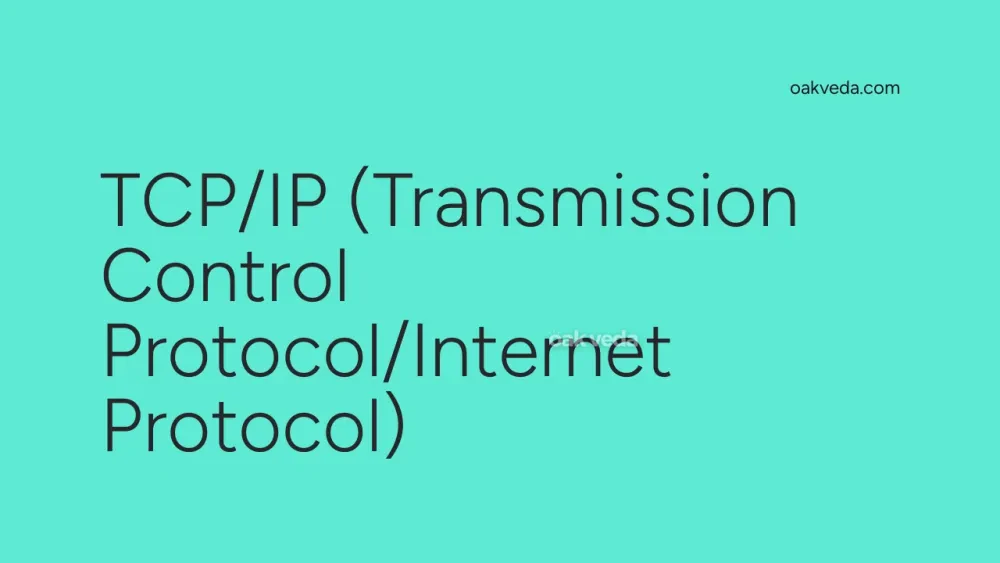
What is the Full Form of TCP/IP?
TCP/IP is the abbreviated form of Transmission Control Protocol/Internet Protocol. This set of communication protocols forms the foundation of the internet and most modern computer networks. Understanding TCP/IP is crucial for anyone involved in networking, web development, or IT infrastructure management.
What is Transmission Control Protocol/Internet Protocol?
Transmission Control Protocol/Internet Protocol, commonly known as TCP/IP, is a suite of communication protocols used for connecting devices on the internet and other computer networks. It defines how data should be packaged, addressed, transmitted, routed, and received at the destination. TCP/IP specifies how data is exchanged over the internet by providing end-to-end communications that identify how it should be broken into packets, addressed, transmitted, routed, and received at the destination.
Origin and Development of TCP/IP
The development of TCP/IP dates back to the 1970s. It was created by two DARPA scientists, Vint Cerf and Bob Kahn, in 1978. The protocol suite was designed to enable computers to communicate across interconnected networks, which eventually led to the creation of the internet as we know it today.
Initially developed for the US Department of Defense's ARPANET, TCP/IP was adopted as the standard protocol for ARPANET in 1983. This adoption marked a significant milestone in the history of networking and laid the groundwork for the modern internet.
How does TCP/IP work?
TCP/IP operates on a four-layer model, each with its specific functions:
-
Application Layer: This is the topmost layer that interacts directly with the end-user. It includes protocols like HTTP, FTP, and SMTP.
-
Transport Layer: This layer ensures reliable data transfer. The two main protocols in this layer are TCP and UDP.
-
Internet Layer: This layer handles the routing of data packets across networks. The primary protocol here is IP (Internet Protocol).
-
Network Access Layer: This is the lowest layer that deals with the physical transmission of data.
When data is sent over a network:
- It starts at the Application Layer and moves down the stack.
- Each layer adds its own information to the data.
- At the receiving end, the data moves up the stack, with each layer stripping off its information.
Functions of TCP/IP
TCP/IP performs several crucial functions in network communication:
-
Addressing: IP provides a unique address to each device on the network, ensuring data reaches the correct destination.
-
Routing: IP determines the best path for data packets to travel across networks.
-
Error Checking: TCP ensures that data is delivered accurately and in the correct order.
-
Flow Control: TCP manages the rate of data transmission to prevent network congestion.
-
Fragmentation and Reassembly: Large data is broken into smaller packets for transmission and reassembled at the destination.
Applications of TCP/IP
TCP/IP is ubiquitous in modern networking. Its applications include:
- Internet Connectivity: It's the primary protocol suite for internet communication.
- Email Systems: SMTP, a protocol in the TCP/IP suite, is used for sending emails.
- File Transfer: FTP, another TCP/IP protocol, facilitates file transfers between computers.
- Web Browsing: HTTP, which runs on top of TCP/IP, enables web browsing.
- Remote Access: Protocols like SSH use TCP/IP for secure remote access to systems.
Features of TCP/IP
Key features of TCP/IP include:
- Open Protocol Suite: It's not controlled by any single organization, allowing for widespread adoption and development.
- Scalability: TCP/IP can handle networks of various sizes, from small local networks to the global internet.
- Platform Independence: It works across different hardware and software platforms.
- Reliable Data Transfer: TCP ensures data is delivered accurately and in order.
- Connectionless Communication: UDP, part of TCP/IP, allows for faster, though less reliable, data transmission.
Benefits of TCP/IP
The widespread adoption of TCP/IP brings several benefits:
- Interoperability: Devices from different manufacturers can communicate seamlessly.
- Flexibility: It supports various types of hardware, software, and network technologies.
- Robustness: The network can continue to function even if parts of it fail.
- Standardization: It provides a common language for network communication worldwide.
- Ease of Scaling: Networks can be easily expanded without major infrastructure changes.
Limitations or Challenges of TCP/IP
Despite its widespread use, TCP/IP has some limitations:
- Security: The original design didn't prioritize security, leading to vulnerabilities.
- Address Exhaustion: The IPv4 addressing system is running out of unique addresses.
- Quality of Service: TCP/IP doesn't inherently provide mechanisms for prioritizing certain types of traffic.
- Complexity: The protocol suite can be complex to configure and manage in large networks.
Future Developments in TCP/IP Technology
TCP/IP continues to evolve to meet the changing needs of modern networking:
- IPv6 Adoption: This new version of IP addresses the limitations of IPv4, providing a vastly larger address space.
- Enhanced Security: Protocols like IPsec are being integrated to improve network security.
- Improved Performance: Researchers are working on ways to optimize TCP for high-speed networks.
- IoT Integration: TCP/IP is being adapted for the unique needs of Internet of Things devices.
FAQs on TCP/IP Full Form
-
What does TCP stand for in TCP/IP? TCP stands for Transmission Control Protocol.
-
What does IP stand for in TCP/IP? IP stands for Internet Protocol.
-
Is TCP/IP the same as the internet? No, TCP/IP is the protocol suite that enables internet communication, but it's not the internet itself.
-
Can TCP/IP be used without an internet connection? Yes, TCP/IP can be used in local area networks (LANs) without internet connectivity.
-
What's the difference between TCP and UDP? TCP provides reliable, ordered data transmission, while UDP offers faster but less reliable transmission.
Understanding TCP/IP is crucial in today's interconnected world. As the backbone of internet communication, it continues to shape how we connect, share information, and build networked systems. Whether you're a network administrator, developer, or simply an curious internet user, grasping the fundamentals of TCP/IP can provide valuable insights into the digital world we inhabit.
You may be interested in:

